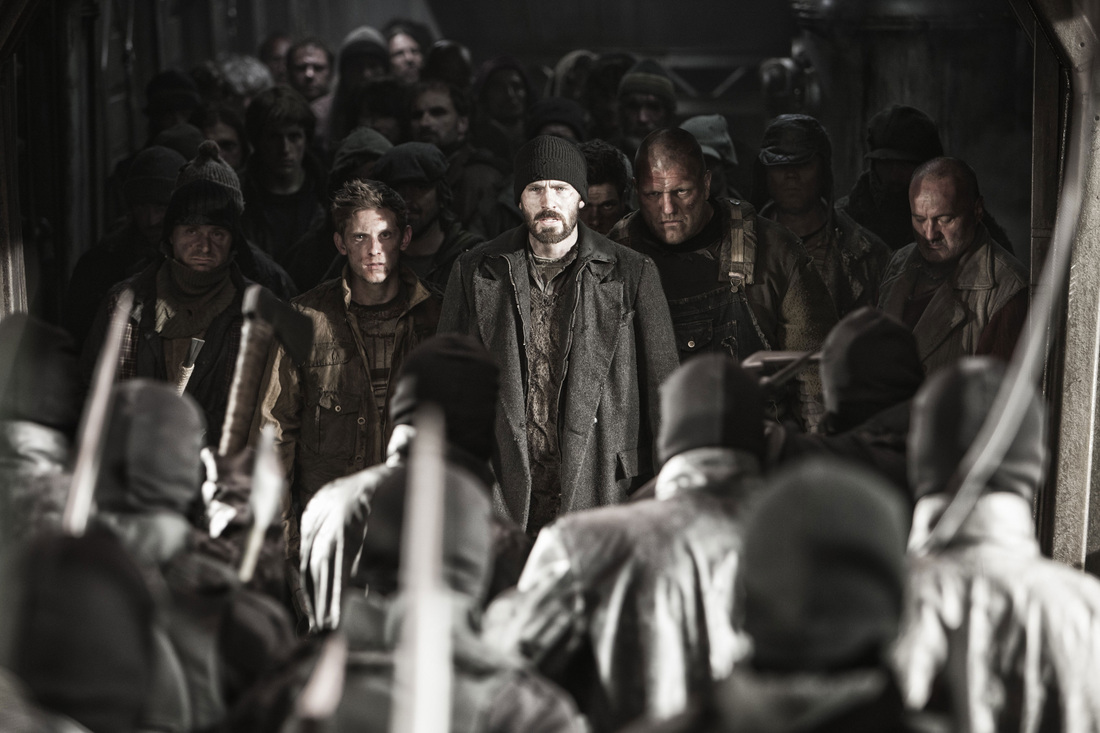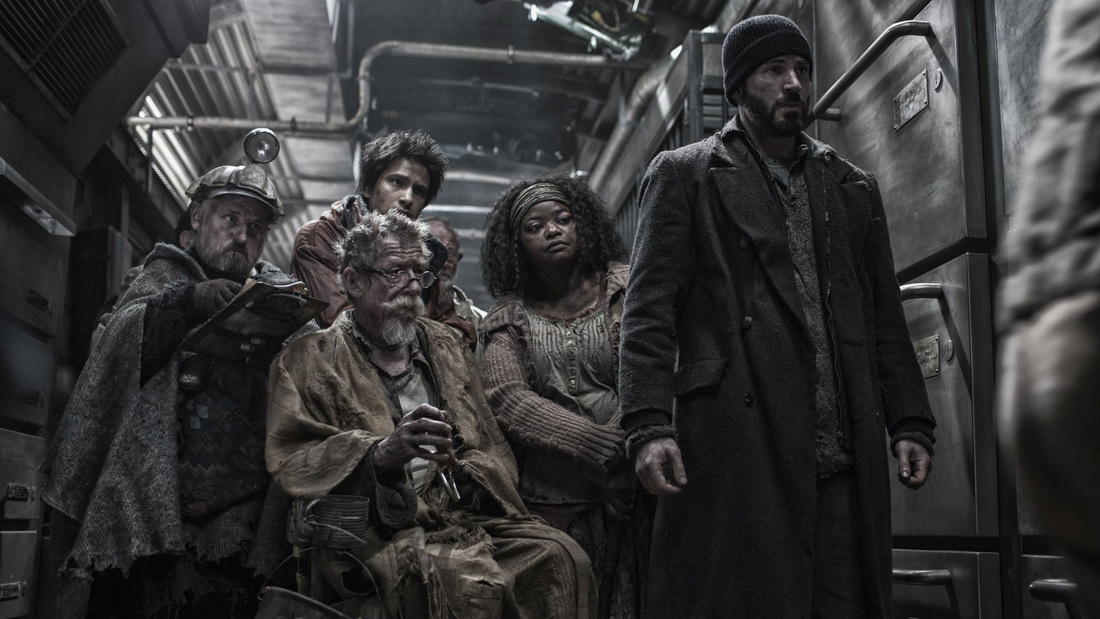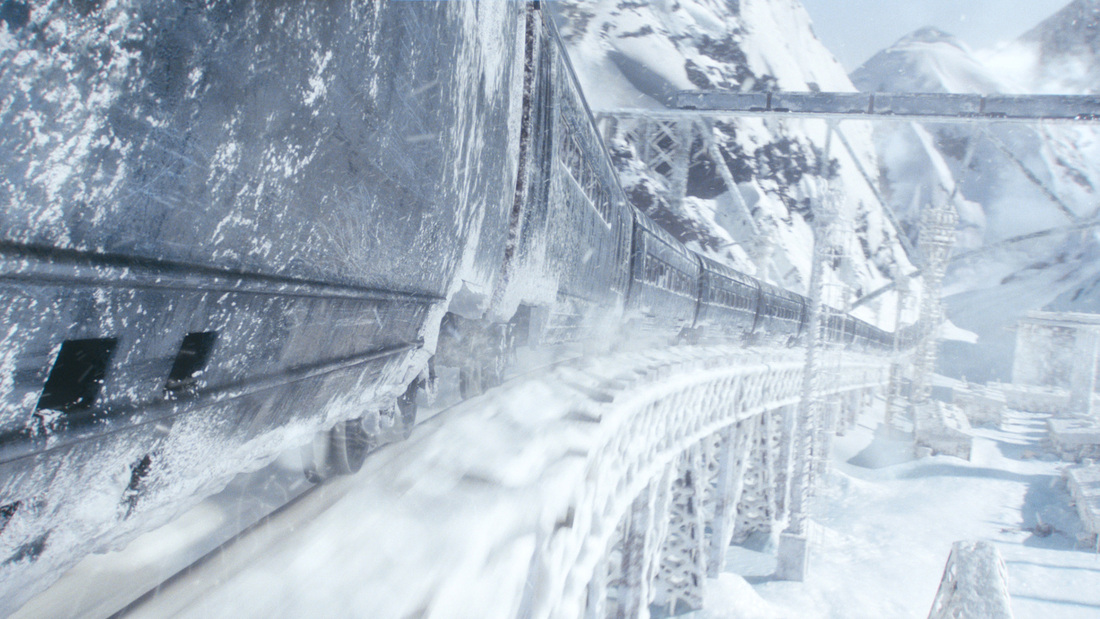Snowpiercer: Piercing Curtis' DecisionsBy Cayce Bower
The perilous journey is almost over. It has been extremely difficult. Leading his people, he has walked through every single train car. Encountering a multitude of unforeseen obstacles, and having watched many of his friends get killed, Curtis has made it to the very front of the train: the engine. Now he is facing a new obstacle. Wilford has been running the engine for years, since the creation of his train, and now, due his old age, he is ready to give up that responsibility and offer it to Curtis. Although tempted by the offer, Curtis eventually refuses and helps stop the train, which was part of his original intent. His doing so derails and basically destroys the train, possibly dooming humanity. Throughout this movie, Curtis makes several important decisions, and they can be argued as either he made the right decisions, or the wrong ones.
This movie’s basic plot is like so many other stories’. “We have some authority or tyranny which imposes a social order and ideology, and the little guy who is the main character has to resist or, simply, cope” (Seed, 393). Snowpiercer is a science-ficiton film, but it is not necessarily what the public may think of when they hear the words “science fiction.” When many cinematically uneducated people hear that, they immediately assume that the story for the movie has to do with something like space and aliens and awesome battles with futuristic technology. “Films do not always become attached to a genre for the same reason: some actively contribute to the development syntax for the genre, others pick up in a less systematic way the traditional elements associated with a genre” (Moine, 57). Snowpiercer has other elements of science fiction, and although it does not fit in as traditionally as other sci-fi films, it is still linked there. It deals with a futuristic almost post-apocalyptic social system, where all that remains of the human race is contained on a single train. The train supports and sustains all the life held on it: humans, plants, fish, and a number of other animals that were deemed worthy to survive on the train. Everything is perfectly balanced, and the balance of life needs to be maintained. As they say in the movie: “What happens when the engine stops? We all freeze and die.” Everyone in the tail end of the train has been living in squalor for the last seventeen years, and they have been planning a revolt to reach the beginning of the train and kill Wilford. They have seen Curtis as their leader, even though he does not see himself as one, expecting him to lead their revolution as he wants it just as much as the rest of them. They also are aware that if for some reason the revolt fails, they would be punished unmercifully, and maybe even killed, by the upper class people such as Mason and Wilford’s henchmen. Examining some of the key decisions of Curtis, we find many of the issues he was facing at the time of those decisions. To start it off, the decision to revolt is obviously a dangerous one. The people in the front of the train basically rule over those in the rear, usually unmercifully. If someone from the tail section steps out of line, they are severely punished. However, if Curtis had not started the revolution, the people in the back of train would have continued suffering through all of the harsh conditions. They had almost no space to themselves, terrible lighting, and a small amount of food. As some of them later discovered, the protein blocks they had been eating were in fact primarily made of insects and other unidentified substances. One of the key events that happened during the revolt was the axe battle when the train travelled through the tunnel. On their way through the train cars, the tail section people were stopped by a blockade of axe-wielding soldiers from the front section. After part of a very bloody battle, the opposing forces called a halt because they were going to be passing over the Yekaterina Bridge, which symbolized the passing of another year. During the pause in the fighting, Mason spoke to the tail sectioners, berating them for turning against Wilford, and all he has done for them, providing them with food and shelter. Then they became aware of a really long tunnel directly after the bridge. They switched off the lights in the train car, because with the train car passing through the tunnel without light, it would be pitch black. All of Mason’s men were equipped with night vision goggles, which would obviously give them a huge advantage in battle because none of the tail sectioners would be able to see a thing. When the train passed through the tunnel, the people from the tail section were scared, because they realized that they were now blind and lost any chance of succeeding in the battle. Curtis realized this was a trap. This was supposed to be where their revolution would be brought to a complete stop. They started swinging blindly to try to keep their opponents at bay for the duration of the ride through the tunnel, but that only worked for so long. Then Mason’s men attacked. It appeared that the tail sectioners were going to be driven back and therefore lose the revolt, until Curtis remembered that they had matches in the tail of the train. Knowing that it was their only chance, he yelled for them to bring the matches forward, and his people behind him kept yelling back until the people in the very last car heard them. It was then that the little boy that held the matches started running a torch toward the front of the train, and passed it off to the one-armed man, who passed it off to another man who ran it to the axe battle to turn the tide of the revolution.
Once the tail sectioners received the torch, they quickly passed on more torches and soon they gained the advantage. This was because many of the soldiers still had their night vision goggles on and could not see as well since there was a lot of light again. When Mason realized what was happening, she started retreating, but not before a well-thrown knife landed in her leg, causing her to stumble. A soldier started helping her to her feet, but then left her because Curtis started to attack her. Before going forward pursuing Mason, he had looked back to a terrifying sight: an enemy soldier was holding a knife to Edgar’s throat. This brings us to another key decision Curtis had to make. Curtis could either go back to try to help Edgar, and probably lose Mason, or continue on after Mason, knowing that Edgar would most likely be killed by the soldier. He needed to get to Mason to end the fighting, but in doing so he would lose his second-in-command. Edgar, his best friend, whose mother he had killed for food years ago when Edgar was but an infant. If he went back to save Edgar, even more lives would be lost, possibly including Edgar’s and his own. It was a terribly painful decision, but after weighing his options, he realized that he needed to let Edgar die so that his people could have a chance at succeeding. He turned back toward Mason, resolved with his decision. Edgar watched him turn away, and a look of disbelief crossed his face as he knew he would die. As the soldier stabbed Edgar, Curtis reached Mason and held his axe to her neck. She screamed for her men to stop attacking and lay down their weapons, and Curtis called for his people to do the same. His decision to pursue Mason yet let Edgar be killed temporarily saved the lives of many of his people. Toward the end of the movie, Curtis is faced with one of the most fatal decisions: whether or not to run the train. When Curtis, Namgoong, and Yona reach the front of the train, Claude shoots Namgoong, and takes Curtis inside to the engine room at gunpoint. It is there that Curtis finally meets the man he hates the most in what is left of the world: Wilford. His original plan was to kill Wilford once he got there, and Gilliam had told him not to let Wilford talk. One thing he had not planned on was someone would have a gun pointed at him, ready to shoot him if the need would arise. Wilford talks to him, congratulating him for making it so far, and offers him to sit down and eat steak, which is something Curtis has not eaten in at least 17 years. Wilford informs Curtis that almost everything Curtis has done was planned, to help keep the population at the right levels. The population was a little too high for the train to keep sustaining, hence people needed to die, so what better way than to stage a revolution? Curtis, although unwilling to accept it at first, learns that the man he had looked up to the most, the man who was like a father to him, Gilliam, was in on the whole thing. He and Wilford had been best friends for years, and with Wilford in the very front of the train, and Gilliam in the back, they had communicated over the phone and planned everything. He informed Curtis that they called this “The Great Curtis Revolution.” Wilford then enticed Curtis with the engine, and asked him if he would run it in his place. This is perhaps the most important decision that Curtis has had to make. If Curtis runs the engine for Wilford, he would be supporting the very thing that he has hated since his arrival on it. But if he did not run the engine, there would be no one else to run it since Wilford was stepping down from that position, and therefore everyone on the train would die, regardless of the social statuses of the people. He needed to make a decision, and Yona helped him choose. While her father was fighting off attackers that were trying to stop them, she had rigged the gate of the front train car to explode. The only thing she needed was a match, and Curtis had the last one. Should he help her blow up the train and end all the madness, or ignore her and watch her and her father eventually die from the swarm of attackers? When she saw Curtis was not going to give her the match, she rushed to a floor tile in the engine room and started to pry it off the floor. Curtis opened it, and looked down to find inside, among much machinery, a small child. Some quick thinking led Curtis to stick his arm through a hole in some gears, enabling him to reach down and take the child out. Then, he loses his arm because he could not hold the gear any longer, he gives the match to Yona, and she lights the fuse to the bomb. The following explosion caused an avalanche, which derailed the train, possibly killing almost every last living being inside it.
Snowpiercer is a very intense movie, and one could certainly argue whether or not Curtis made the wrong decisions. Maybe he did, but the movie portrays these decisions ultimately as good decisions. Due to the destruction of the train from his decision to not run the engine, he ended up saving humanity from spending the rest of eternity on the train. Sources Cited Moine, Raphaëlle. "Looking for the Rules of Genre." Cinema Genre. Malden, MA: Blackwell Pub., 2008. 57. Print. Seed, David. "Philip K. Dick." A Companion to Science Fiction. Malden, MA: Blackwell Pub., 2005. 393. Print. |




